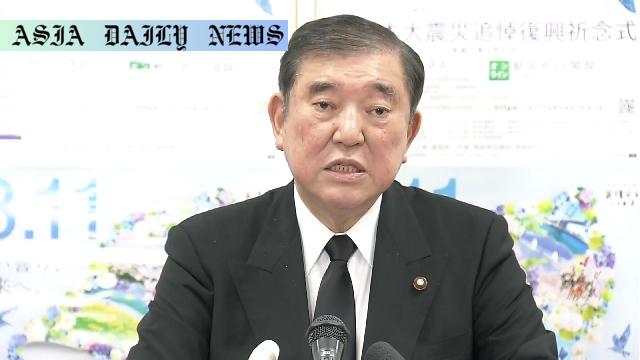Reconstruction: Japan’s PM Ishiba commits sufficient funding for disaster recovery to support livelihoods and nuclear decommissioning.
Reconstruction funding revisited; $10.8 billion allocated for recovery.
Focus on aiding residents’ return, enhancing livelihoods, & nuclear safety.
Lessons from the disaster stressed to inform long-term strategies.
Comprehensive roadmap to guide recovery and decommissioning process.

Japan’s Bold Push for Reconstruction: Critical Plans Ahead
Fourteen years after the tragic earthquake and tsunami disrupted lives across eastern Japan, the government under Prime Minister Ishiba Shigeru is embarking on an ambitious journey to accelerate recovery and chart a future of resilience. Addressing reporters in Fukushima Prefecture—an area emblematic of the disaster’s devastation—Ishiba emphasized the necessity of robust measures to ensure residents can return and reclaim their livelihoods. These strategies come on the heels of the conclusion of the second phase of the reconstruction roadmap, set to end in the coming year.
The third phase, as outlined by Ishiba, will become a pivotal period spanning five years, during which significant focus will be placed on multiple fronts. Key among these is the decommissioning of the reactors at the crippled Fukushima Daiichi nuclear plant—an arduous endeavor that demands technological innovation, international collaboration, and unwavering governmental oversight. Additionally, the issue of final disposal of contaminated soil from decontamination will be addressed with a priority on safety and sustainability, ensuring the environment and public health are not compromised further.
Prioritizing Funding and Policy for Effective Recovery
A major highlight of Ishiba’s announcement was the financial ambitions laid out to support reconstruction and decommissioning. The government aims to secure funding surpassing the 1.6 trillion yen allocated in the prior five-year phase. By summer of next year, the administration plans to revise its basic policy, tailoring it to tackle the complex challenges of restoring the economy, infrastructure, and the displaced population’s well-being.
Ishiba asserts that these plans represent more than fiscal commitments; they serve as a solemn promise to honor the memory of thousands of lives lost and to ensure a brighter future for those left behind. The Reconstruction Agency has been designated as the operational command, while Cabinet ministers will shoulder execution-level responsibilities. Unified leadership and accountability are expected to yield results.
Navigating Complex Challenges Ahead
Although Ishiba struck an optimistic tone, he acknowledged the delays and challenges in the decommissioning process, with some portions experiencing setbacks. Nevertheless, he reassured the nation that the broader goals remain intact and achievable. The emphasis on technological advancement, safety, and transparent communication will be integral to overcoming barriers and staying on course. As Japan continues to heal and rebuild, lessons from the 2011 disaster are central to creating a more secure and resilient nation.
In conclusion, Ishiba’s pledge to secure resources and maintain a steadfast commitment to recovery underscores a government that remains at the forefront of Japan’s rejuvenation. His remarks highlight not only the intent but also the concrete steps needed to honor the past while building a sustainable future.



Commentary
Reflecting on Japan’s Journey of Resilience
The disaster that struck Japan in 2011 remains a pressing reminder of nature’s unparalleled power and the vulnerabilities of mankind. Prime Minister Ishiba’s renewed pledge to push forward with reconstruction efforts offers both hope and a sense of accountability—critical elements for a nation still grappling with the aftermath years later. As we examine his strategic priorities, it is evident that Japan is confronting a complex web of economic, social, and environmental challenges.
What stands out most in Ishiba’s announcement is the clarity of his intentions. The threefold approach centered on recovery funding, the return of displaced populations, and the completion of nuclear decommissioning speaks to a broader vision well beyond mere mitigation. It reaches towards reinvention and resilience. Yet, the reality that portions of the decommissioning roadmap are delayed signals the magnitude of the challenges ahead. The nation’s ability to remain steadfast amidst uncertainty will determine the viability of its reconstruction roadmap in the coming years.
Lessons and Leadership: Embracing a Future of Accountability
Another key takeaway from Ishiba’s framework for recovery is the emphasis on lessons learned. Traumatic events like the 2011 disaster necessitate a willingness to evaluate missteps and apply newfound knowledge, not only to ensure a better future for Japan but also to set a global example in disaster preparedness and nuclear safety. The message reverberates far beyond the borders of Fukushima—a universal principle of responsibility and the quiet promise of progress. In this respect, Japan’s chief challenge is not only technical or financial; it is moral.
While optimism is palpable in Ishiba’s words, it is met with an undercurrent of realism. The next phase, undoubtedly arduous, will test Japan’s policy frameworks, technologies, and even its culture of unity. If it can succeed, this chapter in the nation’s history will not only signify recovery but also a testament to the unyielding human spirit and the pursuit of hope in the face of trials.